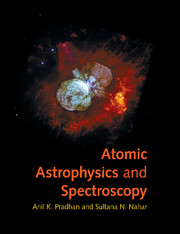Book contents
- Frontmatter
- Contents
- Preface
- Acknowledgements
- 1 Introduction
- 2 Atomic structure
- 3 Atomic processes
- 4 Radiative transitions
- 5 Electron–ion collisions
- 6 Photoionization
- 7 Electron–ion recombination
- 8 Multi-wavelength emission spectra
- 9 Absorption lines and radiative transfer
- 10 Stellar properties and spectra
- 11 Opacity and radiative forces
- 12 Gaseous nebulae and H II regions
- 13 Active galactic nuclei and quasars
- 14 Cosmology
- Appendix A Periodic table
- Appendix B Physical constants
- Appendix C Angular algebra and generalized radiative transitions
- Appendix D Coefficients of the fine structure components of an LS multiplet
- Appendix E Effective collision strengths and A-values
- References
- Index
11 - Opacity and radiative forces
Published online by Cambridge University Press: 05 June 2012
- Frontmatter
- Contents
- Preface
- Acknowledgements
- 1 Introduction
- 2 Atomic structure
- 3 Atomic processes
- 4 Radiative transitions
- 5 Electron–ion collisions
- 6 Photoionization
- 7 Electron–ion recombination
- 8 Multi-wavelength emission spectra
- 9 Absorption lines and radiative transfer
- 10 Stellar properties and spectra
- 11 Opacity and radiative forces
- 12 Gaseous nebulae and H II regions
- 13 Active galactic nuclei and quasars
- 14 Cosmology
- Appendix A Periodic table
- Appendix B Physical constants
- Appendix C Angular algebra and generalized radiative transitions
- Appendix D Coefficients of the fine structure components of an LS multiplet
- Appendix E Effective collision strengths and A-values
- References
- Index
Summary
An elaborate radiative transfer treatment (Chapter 9) is necessary for stellar atmospheres through which radiation escapes the star. But that, in a manner of speaking, is only the visible ‘skin’ of the star, with the remainder of the body opaque to the observer. Radiation transport throughout most of the star is therefore fundamentally different from that through the stellar atmosphere. Since radiation is essentially trapped locally, quite different methods need to be employed to determine the opacity in the interior of the star. However, since there is net outward propagation of radiation from the interior to the surface, it must depend on the variation of temperature and pressure with radius, as in Fig. 10.5.
Perhaps nowhere else is the application of large-scale quantum mechanics to astronomy more valuable than in the computation of astrophysical opacities. Whereas the primary problem to be solved is radiation transport in stellar models, the opacities and atomic parameters needed to calculate them are applicable to a wide variety of problems. One interesting example is that of abundances of elements in stars, including the Sun. Observationally, the composition of the star is inferred from spectral measurements of the atmospheres of stars, i.e. surface abundances, because most of the interior of the star is not amenable to direct observation. However, radiative forces acting on certain elements may affect surface abundances that may be considered abnormal in some stars.
- Type
- Chapter
- Information
- Atomic Astrophysics and Spectroscopy , pp. 239 - 256Publisher: Cambridge University PressPrint publication year: 2011

